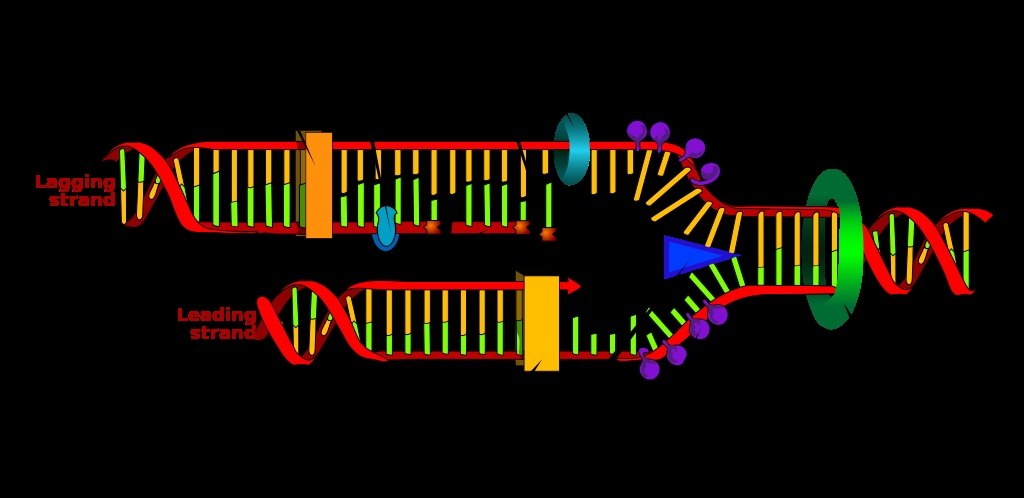
We already know that all living things, from humans to amoebas, reproduce using the same basic method: cell division. DNA, the genetic material inside our cells, has to be copied so that the new offspring cells have the same genetic code as the parent. Let’s see how this process, called DNA replication, works.
The Structure of DNA:
DNA, or Deoxyribonucleic acid, looks like a ladder. This is because it is made up of two long strands of nucleotides whose nitrogen bases meet in the middle. We call this structure the double helix because the long strands twist around each other. The nucleotides that make up the strands in DNA are molecules including a phosphate group, a sugar group, and a nitrogen base. The nitrogen bases in the middle of one strand pair up with the bases of the other, and the way these bases are arranged will determine which genes are coded for. The four nitrogenous bases are A,T,C, and G, and A pairs with T while C pairs with G. This means if a nucleotide on one side of the ladder has a C as its half of the ladder “rung”, then the nucleotide across from it must have a G as its base.
How Replication Works:
Because of this unique structure, DNA replication requires the help of several enzymes, or proteins that act as catalysts in chemical reactions, to ensure that each strand of DNA is copied. This will ensure the daughter cells inherit genes contained in the parent’s double-stranded DNA.
Step One: Opening the Double Helix
In order for replication to begin, a protein we call the initiator unwinds a short length of the double helix to flatten it out. Now a protein called helicase can move in, attaching to the strands and breaking the hydrogen bonds that hold the bases from each strand together. Splitting the double helix can’t just happen anywhere in the chain, however. Helicase attaches to the origin of replication, or a specific sequence of base pairs that make it easier for the strands to separate. This is in the middle of the chain somewhere, so you can picture how unwinding and opening the “ladder” here creates a “replication bubble”. Helicase works its way down the DNA strand until there are two separate chains of polynucleotides.
Step Two: Priming the Template
While helicase separates the DNA strands, another enzyme called primase attaches to each strand to assemble a specific arrangement of nucleotides called the primer. This is important because the protein that actually replicates DNA, called DNA polymerase, can only add new DNA molecules to an already-existing strand of nucleotides. The primer will usually be made up of about 18-22 bases and is removed later in the process.
Step Three: Generating the Copy
DNA polymerase wraps itself around each single strand and attaches one nucleotide for each exposed base. The bases inserted will be complementary to the bases on the template strand, which ensures that the new strand will contain the same sequence. The process of replication is fairly quick, occuring at 50 nucleotides per second in human DNA, thanks to multiple polymerases that can synthesize at the same time. This means while one strand of the original template DNA is replicated, the other is being replicated as well. One of the strands will be referred to as the leading strand – this one is synthesized continuously. The other strand is known as the lagging strand and is copied in shorter separate fragments that are eventually connected together. This has to happen because DNA polymerase can only synthesize DNA in one direction, but the strands run opposite to each other. The smaller fragments of the new DNA strand that have to be joined together are referred to as Okazaki fragments. They are sealed together into one continuous strand by an enzyme called DNA ligase.
Avoiding Errors
DNA polymerase is an amazing enzyme – it actually proofreads its own work and removes most of the incorrect nucleotides that are accidentally added to the new copy strand. Another protein that keeps things running smoothly is called topoisomerase, which makes temporary cuts in the helix ahead of the replication bubble to ensure the rest of the DNA doesn’t get too tightly wound up. Topoisomerase then seals up any cuts it makes during the replication process.
Last Step: Creating the New Double Strand
After the DNA strands are proofread, DNA ligase seals up the copies into two continuous double strands. The DNA will automatically wind up into a double helix itself. Once the process is over, you will be left with two double-stranded DNA molecules, and each will contain one strand that was part of the original that was copied, and one new strand that DNA polymerase synthesized. This is why we describe DNA replication as semi-conservative – because part of the new DNA is the exact same as the original.

Nikki Collins is a freelance writer and scientist. Her scientific experience ranges from academic research at IU School of Medicine to the public health arena working in institutions such as Centers for Disease Control and Prevention (CDC). When not in a lab or at a computer, she enjoys almost anything outdoors, dance, and reading.
